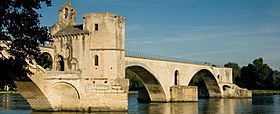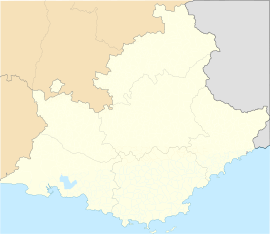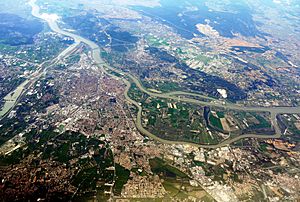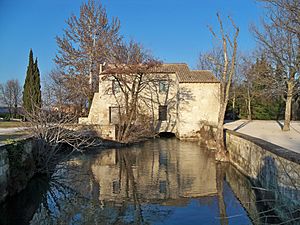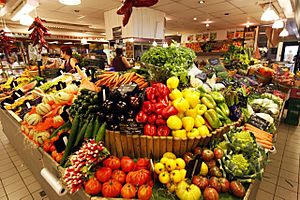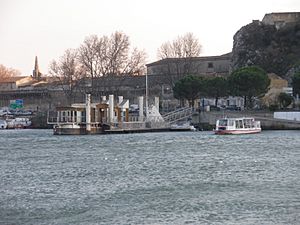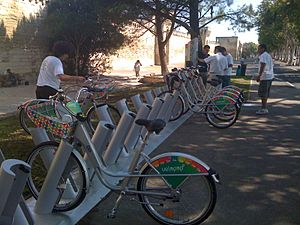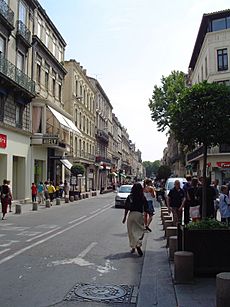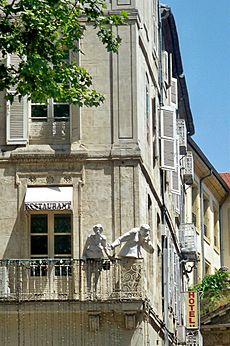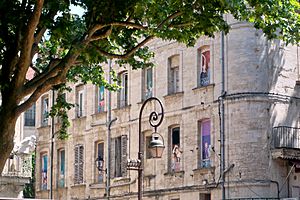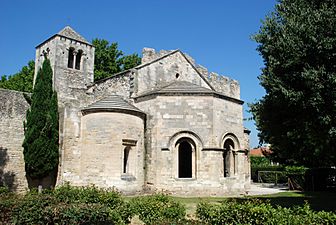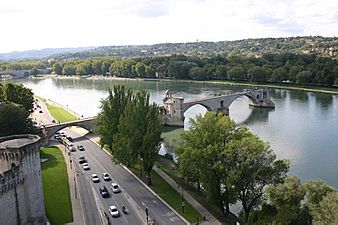Avignon facts for kids
Quick facts for kids
Avignon
Avinhon (Occitan)
|
||
|---|---|---|
|
Prefecture and commune
|
||
|
From top: city skyline,
Rocher des Doms, Palais des Papes, Pont Saint-Bénézet, Avignon Cathedral, Festival d'Avignon |
||
|
||
| Country | France | |
| Region | Provence-Alpes-Côte d'Azur | |
| Department | Vaucluse | |
| Arrondissement | Avignon | |
| Canton | Avignon-1, Avignon-2, Avignon-3 | |
| Intercommunality | CA Grand Avignon | |
| Area
1
|
64.78 km2 (25.01 sq mi) | |
| Population
(2021)
|
90,330 | |
| • Density | 1,394.41/km2 (3,611.5/sq mi) | |
| • Urban
(2020)
|
459,533 | |
| • Metro
(2020)
|
337,039 | |
| Time zone | UTC+01:00 (CET) | |
| • Summer (DST) | UTC+02:00 (CEST) | |
| INSEE/Postal code |
84007 /84000
|
|
| Elevation | 10–122 m (33–400 ft) (avg. 23 m or 75 ft) |
|
| UNESCO World Heritage Site | ||
| Official name | Historic Centre of Avignon: Papal Palace, Episcopal Ensemble and Avignon Bridge | |
| Criteria | Cultural: i, ii, iv | |
| Inscription | 1995 (19th Session) | |
| Area | 8.2 ha | |
| 1 French Land Register data, which excludes lakes, ponds, glaciers > 1 km2 (0.386 sq mi or 247 acres) and river estuaries. | ||
Avignon is a famous city in southeastern France. It's the capital of the Vaucluse area in the Provence-Alpes-Côte d'Azur region. The city sits on the left bank of the Rhône river. In 2017, about 93,671 people lived there. Around 16,000 of them lived inside the old city center, which is still surrounded by its medieval walls.
Avignon is known as "La Cité des Papes" (The City of Popes). This is because, from 1309 to 1377, seven popes lived here during a time called the Avignon Papacy. In 1348, Pope Clement VI even bought the town. Avignon remained under papal control until 1791, when it became part of France during the French Revolution.
The historic center of Avignon, including the amazing Palais des Papes (Papal Palace), the cathedral, and the famous Pont d'Avignon, became a World Heritage Site in 1995. This was because of its important buildings and its role in the 14th and 15th centuries. These old monuments and the yearly Festival d'Avignon, one of the world's biggest performing arts festivals, make Avignon a popular place for tourists.
Contents
About the Name
The name "Avignon" comes from very old words. The ancient Greeks called it Aueniṑn. The Romans later called it Avennĭo Cavărum, meaning "Avignon of the Cavares." The Cavares were a Celtic-Ligurian tribe who lived in this area.
The name might be linked to the Rhône river or the Rocher des Doms, a big rock in the city. Today, people from Avignon are called avinhonencs or avignounen in the local Occitan language.
History
Geography
Avignon is located on the left bank of the Rhône river. It's a few kilometers upstream from where the Durance river joins the Rhône. The city is about 580 kilometers (360 miles) southeast of Paris and 85 kilometers (53 miles) north-north-west of Marseille.
The city is near other towns like Orange to the north, and Nîmes and Marseille to the south.
Land and Rocks
The area around Avignon has a lot of limestone. This stone was used to build many structures, including the city walls. The current city walls are 4,330 meters (2.7 miles) long. They were built using a soft limestone found nearby.
Inside the city walls, there's a 35-meter (115-foot) high limestone hill called the Rocher des Doms. This rock was the original center of the city and was safe from floods.
The Rhone Valley is an old area filled with river deposits like sand and pebbles. The islands in the Rhône, like the Île de la Barthelasse, were formed by these deposits and also by human work.
Rivers and Waterways

The Rhône river flows past the western side of Avignon. It splits into two parts around an island called the Île de la Barthelasse. The Petit Rhône flows next to Avignon, and the Grand Rhône flows on the other side, past Villeneuve-lès-Avignon.
The banks of the Rhône and the Île de la Barthelasse often flood, especially in autumn and March. Big floods have happened many times in history, like in 1856 and 2003.
The Durance river flows along the southern edge of the city and joins the Rhône. This river is known for its changing water levels, sometimes flooding and sometimes having very low water.
There are also many natural and man-made lakes in the area, like the Lake of Saint-Chamand.
Man-made Water Channels
Over time, people have built many channels to move water. These channels were used to fill the moats around Avignon's walls or to water crops.
For example, in the 10th century, water from the Sorgue d'Entraigues was redirected to flow under the city walls. This channel is now called the Vaucluse Canal. It helped fill the moats of the city's defenses. Other canals, like the Durançole, were built to bring water from the Durance river for irrigation and to power mills. Many of these old channels are now hidden beneath the streets.
Earthquakes
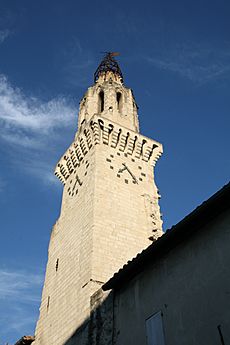
Avignon is in an area with a moderate risk of earthquakes. The last big earthquake happened on June 11, 1909. It caused the bell tower of the Augustinians' Church to lean slightly, and you can still see it today!
Climate
Avignon has a hot-summer mediterranean climate. This means it has mild winters and hot summers. It gets a moderate amount of rain throughout the year. The city is often windy, especially because of a strong wind called the mistral. An old saying about Avignon was: "Windy Avignon, pest-ridden when there is no wind, wind-pestered when there is."
| Climate data for Avignon (1991–2020 averages, extremes 1993–present) | |||||||||||||
|---|---|---|---|---|---|---|---|---|---|---|---|---|---|
| Month | Jan | Feb | Mar | Apr | May | Jun | Jul | Aug | Sep | Oct | Nov | Dec | Year |
| Record high °C (°F) | 20.8 (69.4) |
23.1 (73.6) |
26.7 (80.1) |
31.4 (88.5) |
34.2 (93.6) |
42.8 (109.0) |
39.6 (103.3) |
42.0 (107.6) |
35.5 (95.9) |
31.0 (87.8) |
23.8 (74.8) |
19.3 (66.7) |
42.8 (109.0) |
| Mean daily maximum °C (°F) | 10.7 (51.3) |
12.4 (54.3) |
16.6 (61.9) |
19.7 (67.5) |
23.9 (75.0) |
28.7 (83.7) |
31.5 (88.7) |
31.1 (88.0) |
26.0 (78.8) |
21.0 (69.8) |
14.7 (58.5) |
11.0 (51.8) |
20.6 (69.1) |
| Daily mean °C (°F) | 6.3 (43.3) |
7.4 (45.3) |
10.8 (51.4) |
13.7 (56.7) |
17.8 (64.0) |
22.1 (71.8) |
24.8 (76.6) |
24.3 (75.7) |
19.9 (67.8) |
15.8 (60.4) |
10.3 (50.5) |
6.7 (44.1) |
15.0 (59.0) |
| Mean daily minimum °C (°F) | 1.9 (35.4) |
2.3 (36.1) |
5.0 (41.0) |
7.7 (45.9) |
11.7 (53.1) |
15.6 (60.1) |
18.0 (64.4) |
17.6 (63.7) |
13.9 (57.0) |
10.7 (51.3) |
6.0 (42.8) |
2.5 (36.5) |
9.4 (48.9) |
| Record low °C (°F) | −8.7 (16.3) |
−7.8 (18.0) |
−9.9 (14.2) |
−4.2 (24.4) |
2.4 (36.3) |
6.7 (44.1) |
10.7 (51.3) |
9.5 (49.1) |
5.5 (41.9) |
−2 (28) |
−7.1 (19.2) |
−8.6 (16.5) |
−9.9 (14.2) |
| Average precipitation mm (inches) | 55.6 (2.19) |
35.6 (1.40) |
36.1 (1.42) |
59.9 (2.36) |
52.3 (2.06) |
35.2 (1.39) |
23.9 (0.94) |
35.0 (1.38) |
91.1 (3.59) |
88.6 (3.49) |
92.0 (3.62) |
43.5 (1.71) |
648.8 (25.54) |
| Average precipitation days (≥ 1.0 mm) | 5.7 | 4.8 | 4.4 | 6.5 | 6.0 | 3.7 | 2.6 | 3.3 | 5.2 | 6.0 | 7.5 | 5.2 | 60.9 |
| Source: Météo France | |||||||||||||
The highest temperature ever recorded in Avignon was 42.8 °C (109.0 °F) on June 28, 2019. The lowest was −14.5 °C (5.9 °F) on February 2, 1956.
The Mistral Wind
The mistral is the strongest wind in Avignon. It can blow faster than 110 kilometers per hour (68 mph). It blows between 120 and 160 days each year.
| Jan. | Feb. | Mar. | Apr. | May. | Jun. | Jul. | Aug. | Sep. | Oct. | Nov. | Dec. | |
|---|---|---|---|---|---|---|---|---|---|---|---|---|
| Maximum recorded speed by month | 106 | 127 | 119 | 97 | 94 | 144 | 90 | 90 | 90 | 87 | 91 | 118 |
| Tendency: Days with speed > 16 m/s (58 km/h) |
-- | +++ | --- | ++++ | ++++ | = | = | ++++ | + | --- | = | ++ |
Population
In 2017, Avignon had 91,921 people living there.
| Historical population | |||||||||||||||||||||||||||||||||||||||||||||||||||||||||||||||||||||||||||||||||||||||||||||||||||||||||||||||||||
|---|---|---|---|---|---|---|---|---|---|---|---|---|---|---|---|---|---|---|---|---|---|---|---|---|---|---|---|---|---|---|---|---|---|---|---|---|---|---|---|---|---|---|---|---|---|---|---|---|---|---|---|---|---|---|---|---|---|---|---|---|---|---|---|---|---|---|---|---|---|---|---|---|---|---|---|---|---|---|---|---|---|---|---|---|---|---|---|---|---|---|---|---|---|---|---|---|---|---|---|---|---|---|---|---|---|---|---|---|---|---|---|---|---|---|---|
|
|
||||||||||||||||||||||||||||||||||||||||||||||||||||||||||||||||||||||||||||||||||||||||||||||||||||||||||||||||||
| Source: EHESS and INSEE | |||||||||||||||||||||||||||||||||||||||||||||||||||||||||||||||||||||||||||||||||||||||||||||||||||||||||||||||||||
City Government
Avignon is the prefecture, or capital, of the Vaucluse area in France. It's also the center of a larger group of 15 towns called the Grand Avignon metropolitan area. These towns are located on both sides of the Rhône river.
Mayors of Avignon
Here are some of the recent mayors of Avignon:
| From | To | Name | Party |
|---|---|---|---|
| 1940 | 1942 | Jean Gauger | |
| 1942 | 1944 | Edmond Pailheret | |
| 1944 | 1945 | Louis Gros | |
| 1945 | 1947 | Georges Pons | |
| 1947 | 1948 | Paul Rouvier | |
| 1948 | 1950 | Henri Mazo | |
| 1950 | 1953 | Noël Hermitte | |
| 1953 | 1958 | Edouard Daladier | |
| 1958 | 1983 | Henri Duffaut | PS |
| 1983 | 1989 | Jean-Pierre Roux | RPR |
| 1989 | 1995 | Guy Ravier | PS |
| 1995 | 2014 | Marie-José Roig | UMP |
| 2014 | 2026 | Cécile Helle | PS then DVG |
Sister Cities
Avignon has "sister city" relationships with several cities around the world. This means they share cultural and educational ties.
- Colchester, United Kingdom (since 1972)
- Guanajuato, Mexico (since 1990)
- Diourbel, Senegal (since 1961)
- New Haven, Connecticut, USA (since 1993)
- Siena, Italy (since 1981)
- Tarragona, Spain (since 1968)
- Tortosa, Spain (since 1968)
- Wetzlar, Germany (since 1960)
Size and Population Rank
Avignon covers an area of 64.78 square kilometers (25 square miles). In 2010, it had 92,078 people. Here's how it ranks in France:
| Rank | Land Area | Population | Density |
|---|---|---|---|
| France | 524th | 46th | 632nd |
| Provence-Alpes-Côte d'Azur | 105th | 5th | 23rd |
| Vaucluse | 6th | 1st | 2nd |
Economy
Avignon is an important economic center. It has many businesses, shops, and service providers. The city's urban area is one of the largest shopping areas in Europe.
The service industry is very active here, especially because the Vaucluse region produces a lot of fruits and vegetables. Avignon has a big national market for these products.
Main Business Areas
Avignon has several main areas where businesses are located. The Courtine area is the largest, with almost 300 businesses and over 3,600 jobs. It's located near the TGV train station. Other important areas include Fontcouverte and Agroparc.
Tourism
About four million visitors come to Avignon each year. They come to see the city and the region, and especially for the Festival d'Avignon. In 2011, the Palais des Papes (Papal Palace) was the most visited attraction, with over 570,000 paying visitors. The annual Festival d'Avignon is the city's biggest cultural event.
River tourism is also popular. Many cruise boats dock at Avignon, offering tours along the Rhône. There's even a free shuttle boat that connects Avignon to the Île de la Barthelasse, an island in the river.
Agriculture
Avignon is a key place for agriculture. It's the headquarters for groups like the International Association of the Mediterranean Tomato.
Jobs
In 2017, the unemployment rate in Avignon was 26.0%. The city's workforce includes people in agriculture, trades, business management, and many other jobs.
Transport
Roads
Avignon is close to two major highways:
- The A7 autoroute (E714) runs north-south.
- The A9 autoroute (E15) goes towards Spain.
The city has many parking areas, including paid multi-story car parks and free parking zones.
Railways
Avignon has two train stations:
- The historic Gare d'Avignon-Centre, built in 1860, is just outside the city walls.
- The Gare d'Avignon TGV, opened in 2001, is for high-speed trains.
These two stations have been connected by a special link line since 2013.
Airports
The Avignon - Caumont Airport has flights to England. For more flights, the larger Marseille Provence Airport is nearby.
Water Transport
The Rhône river has been important for transport in Avignon for centuries. The city has commercial ports and docking stations for river cruises. A free shuttle boat crosses the river to the Île de la Barthelasse.
Public Transport
Avignon has a public transport system called the Orizo network. It includes bus services, bike sharing, and car pooling. A new tramway system also opened in October 2019.
Bicycles
Avignon has 110 kilometers (68 miles) of bicycle paths. In 2009, a bicycle sharing system called Vélopop' was introduced.
Cultural Heritage
Avignon has many historic sites and buildings, with 177 of them registered as historical monuments.
Inside the city walls, many buildings are old but have been restored. The main street, Rue de la République, has buildings from the 1800s. The central square, Place de l'Horloge, has the city hall and theater district.
Here are some of the main attractions:
- Notre Dame des Doms (12th century): This is the city's cathedral. It's a Romanesque building with a large gilded statue of the Virgin Mary on top. Inside, you can see the tomb of Pope John XXII.
- Palais des Papes (Papal Palace) (14th century): This huge palace was built by the popes and is a very important monument. It was started in 1316 and finished around 1370.
- Churches: Avignon has several beautiful Gothic churches, including Saint-Pierre, Saint-Didier, and Saint-Agricol, all from the 14th century.
- City Walls: The city walls were built by the popes in the 14th century. They still surround Avignon and are a great example of medieval fortification. They are very strong, with 39 towers and several gates.
- Bridges:
* The Pont Saint-Bénézet, also known as the Pont d'Avignon, is famous from the French song. Only four of its original twenty-one arches remain. * Other bridges like the Pont Édouard Daladier and Pont de l'Europe now cross the Rhône.
- Calvet Museum: This museum has a large collection of paintings and other objects, given to the city by a doctor named Esprit Calvet in 1810.
- Musée du Petit Palais (opened 1976): Located near the Papal Palace, this museum has an amazing collection of Renaissance paintings.
- Les Halles: This is a big indoor market where you can find fresh food like fruits, vegetables, meats, and fish.
- Place Pie: A lively square near Place de l'Horloge, perfect for enjoying a coffee or meeting friends in the evening.
- Note about Picasso: The famous painting Les Demoiselles d'Avignon by Pablo Picasso is not about women from the city of Avignon. It's about women from a street in Barcelona called Carrer d'Avinyó.
The city has over 500 historical objects.
Gallery
-
The Pont d'Avignon from the song "Sur le Pont d'Avignon"
Culture
Avignon Festival
Every summer, Avignon hosts a big theatre festival called the Festival d'Avignon. It started in 1947 and includes theatre, dance, music, and cinema. The festival uses the city's historic buildings as stages. About 100,000 people attend each year. There are two parts: the "Festival In," which has official plays in places like the Palace of the Popes, and the "Festival Off," which features new plays and street performances.
The festival was started by Jean Vilar. It brings a lot of visitors and helps the local economy. Tourists often explore nearby villages and enjoy local food and wines.
International Congress Centre
This center was built in 1976 inside the Papal Palace. It hosts many events, conventions, and meetings throughout the year.
"Sur le Pont d'Avignon"
Avignon is famous for the French song 'Sur le Pont d'Avignon' ('On the bridge of Avignon'), which describes folk dancing. The song became popular in the mid-1800s.
The bridge in the song is the Pont Saint-Bénézet over the Rhône river. Only four of its original 22 arches are left. The bridge was first built between 1171 and 1185 but was often damaged by floods. It was finally abandoned in 1669.
Sport
- Sporting Olympique Avignon is the city's local rugby league team.
- AC Arles-Avignon was a professional football (soccer) team that played at the Parc des Sports.
Education
Schools in Avignon are managed by the Académie d'Aix-Marseille. There are 26 state nursery schools for young children and 32 state primary schools. There are also 4 private schools.
University of Avignon
Old University
The first University of Avignon was officially started in 1303 by Boniface VIII. It was especially known for its Law department. Later, it added departments for theology and medicine. The university was very important in the city until it closed in 1792 during the French Revolution.
Modern University
A new university, the Université d'Avignon et des Pays de Vaucluse, was created in 1984. This was almost 200 years after the first one closed. The main campus is located in the city center, inside the old city walls. It uses buildings that were once part of the 18th-century Hôpital Sainte-Marthe. In 2009–2010, over 7,000 students were enrolled there.
Notable People
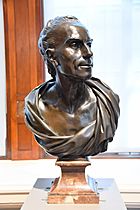

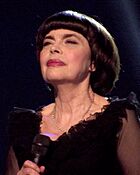
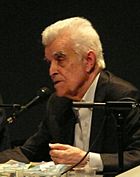
Many interesting people have come from or lived in Avignon:
The Arts
- Nicolas Dipre (c. 1495–1532), an early Renaissance painter.
- Claude-Joseph Vernet (1714–1789), a painter known for night landscapes.
- Albert Gleizes (1881–1953), an artist and a founder of Cubism.
Music
- Olivier Messiaen (1908–1992), a famous composer and organist.
- Mireille Mathieu (born 1946), a well-known singer.
Science & Business
- Alexis-Hubert Jaillot (1632–1712), a geographer and mapmaker.
- Pierre-Esprit Radisson (1636/1640–1710), a fur trader and explorer.
- Honoré Blanc (1736–1801), a gunsmith who helped create interchangeable parts.
Public Service & the Church
- Pope Gregory XI (c. 1329–1378), the last pope to live in Avignon.
- John Stuart Mill (1806–1873), an English philosopher and politician who is buried in Avignon.
- Édouard Daladier (1884–1970), a politician who was Prime Minister of France three times.
- Bernard Kouchner (born 1939), a politician who helped start Médecins Sans Frontières (Doctors Without Borders).
Writing
- Pierre Boulle (1912–1994), author of famous novels like The Bridge over the River Kwai and Planet of the Apes.
- René Girard (1923–2015), a philosopher and literary critic.
Sport
- Philippe Gache (born 1962), a racing driver.
- Jean Alesi (born 1964), a professional Formula 1 racing driver.
- Camille Ayglon (born 1985), a retired handball player who won an Olympic silver medal.
- Benoît Paire (born 1989), a tennis player.
See also
 In Spanish: Aviñón para niños
In Spanish: Aviñón para niños





